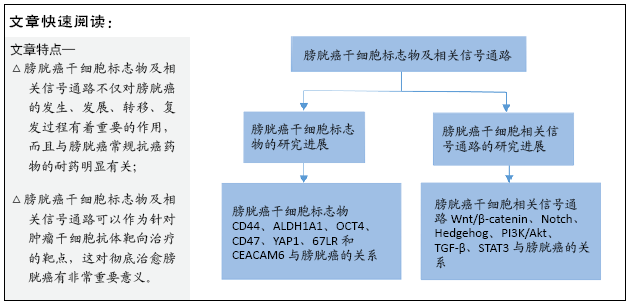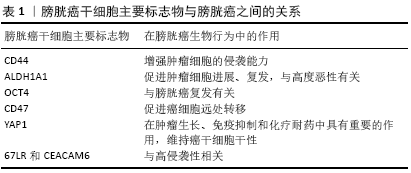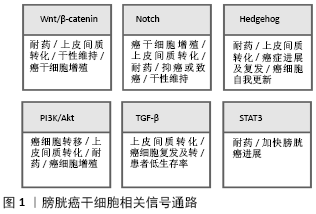[1] FERLAY J, SHIN HR, BRAY F, et al. Estimates of worldwide burden of cancer in 2008: GLOBOCAN 2008. Int J Cancer. 2010;127(12): 2893-2917.
[2] KAMAT AM, HAHN NM, EFSTATHIOU JA, et al. Bladder cancer. Lancet. 2016;388(10061):2796-2810.
[3] LERNER SP, BAJORIN DF, DINNEY CP, et al. Summary and Recommendations from the National Cancer Institute’s Clinical Trials Planning Meeting on Novel Therapeutics for Non-Muscle Invasive Bladder Cancer. Bladder Cancer. 2016;2(2):165-202.
[4] MALKOWICZ SB, VAN POPPEL H, MICKISCH G, et al. Muscle-invasive urothelial carcinoma of the bladder. Urology. 2007;69(1 Suppl):3-16.
[5] ŚLUSARCZYK A, ZAPAŁA P, ZAPAŁA Ł, et al. Prediction of BCG responses in non-muscle-invasive bladder cancer in the era of novel immunotherapeutics. Int Urol Nephrol. 2019;51(7):1089-1099.
[6] MITRA AP, COTE RJ. Searching for novel therapeutics and targets: insights from clinical trials. Urol Oncol. 2007;25(4):341-343.
[7] VAN DER HORST G, BOS L, VAN DER PLUIJM G. Epithelial plasticity, cancer stem cells, and the tumor-supportive stroma in bladder carcinoma. Mol Cancer Res. 2012;10(8):995-1009.
[8] OHISHI T, KOGA F, MIGITA T. Bladder Cancer Stem-Like Cells: Their Origin and Therapeutic Perspectives. Int J Mol Sci. 2015;17(1):43.
[9] 王海明,石爱平,许宁.膀胱癌干细胞标记物的研究进展[J].中国老年学杂志,2014,34(21):6224-6226.
[10] CHAN KS, VOLKMER JP, WEISSMAN I. Cancer stem cells in bladder cancer: a revisited and evolving concept. Curr Opin Urol. 2010;20(5): 393-397.
[11] GARG M. Urothelial cancer stem cells and epithelial plasticity: current concepts and therapeutic implications in bladder cancer. Cancer Metastasis Rev. 2015;34(4):691-701.
[12] HATINA J, SCHULZ WA. Stem cells in the biology of normal urothelium and urothelial carcinoma. Neoplasma. 2012;59(6):728-736.
[13] ATLASI Y, MOWLA SJ, ZIAEE SA, et al. OCT-4, an embryonic stem cell marker, is highly expressed in bladder cancer. Int J Cancer. 2007;120(7): 1598-1602.
[14] PASCAL LE, DEUTSCH EW, CAMPBELL DS, et al. The urologic epithelial stem cell database (UESC) - a web tool for cell type-specific gene expression and immunohistochemistry images of the prostate and bladder. BMC Urol. 2007;7:19.
[15] FEI DL, LI H, KOZUL CD, et al. Activation of Hedgehog signaling by the environmental toxicant arsenic may contribute to the etiology of arsenic-induced tumors. Cancer Res. 2010 ;70(5):1981-1988.
[16] ZHANG Y, WANG Z, YU J, et al. Cancer stem-like cells contribute to cisplatin resistance and progression in bladder cancer. Cancer Lett. 2012;322(1):70-77.
[17] JORDAN CT. Cancer stem cells: controversial or just misunderstood? Cell Stem Cell. 2009;4(3):203-205.
[18] KLONISCH T, WIECHEC E, HOMBACH-KLONISCH S, et al. Cancer stem cell markers in common cancers - therapeutic implications. Trends Mol Med. 2008;14(10):450-460.
[19] WOODWARD WA, SULMAN EP. Cancer stem cells: markers or biomarkers? Cancer Metastasis Rev. 2008;27(3):459-470.
[20] LI Y, LIN K, YANG Z, et al. Bladder cancer stem cells: clonal origin and therapeutic perspectives. Oncotarget. 2017;8(39):66668-66679.
[21] ELBADAWY M, USUI T, MORI T, et al. Establishment of a novel experimental model for muscle-invasive bladder cancer using a dog bladder cancer organoid culture. Cancer Sci. 2019;110(9):2806-2821.
[22] BANERJEE S, MODI S, MCGINN O, et al. Impaired Synthesis of Stromal Components in Response to Minnelide Improves Vascular Function, Drug Delivery, and Survival in Pancreatic Cancer. Clin Cancer Res. 2016; 22(2):415-425.
[23] WANG L, ZUO X, XIE K, et al. The Role of CD44 and Cancer Stem Cells. Methods Mol Biol. 2018;1692:31-42.
[24] SUGAHARA KN, HIRATA T, HAYASAKA H, et al. Tumor cells enhance their own CD44 cleavage and motility by generating hyaluronan fragments. J Biol Chem. 2006;281(9):5861-5868.
[25] GOLSHANI R, LOPEZ L, ESTRELLA V, et al. Hyaluronic acid synthase-1 expression regulates bladder cancer growth, invasion, and angiogenesis through CD44. Cancer Res. 2008;68(2):483-491.
[26] CHAN KS, ESPINOSA I, CHAO M, et al. Identification, molecular characterization, clinical prognosis, and therapeutic targeting of human bladder tumor-initiating cells. Version 2. Proc Natl Acad Sci U S A. 2009; 106(33):14016-14021.
[27] YANG YM, CHANG JW. Bladder cancer initiating cells (BCICs) are among EMA-CD44v6+ subset: novel methods for isolating undetermined cancer stem (initiating) cells. Cancer Invest. 2008;26(7):725-733.
[28] MURAMAKI M, MIYAKE H, KAMIDONO S, et al. Over expression of CD44V8-10 in human bladder cancer cells decreases their interaction with hyaluronic acid and potentiates their malignant progression. J Urol. 2004;171(1):426-430.
[29] JUNG M, KIM B, MOON KC. Immunohistochemistry of cytokeratin (CK) 5/6, CD44 and CK20 as prognostic biomarkers of non-muscle-invasive papillary upper tract urothelial carcinoma. Histopathology. 2019;74(3):483-493.
[30] SU Y, QIU Q, ZHANG X, et al. Aldehyde dehydrogenase 1 A1-positive cell population is enriched in tumor-initiating cells and associated with progression of bladder cancer. Cancer Epidemiol Biomarkers Prev. 2010;19(2):327-337.
[31] NAMEKAWA T, IKEDA K, HORIE-INOUE K, et al. ALDH1A1 in patient-derived bladder cancer spheroids activates retinoic acid signaling leading to TUBB3 overexpression and tumor progression. Int J Cancer. 2020;146(4):1099-1113.
[32] ORYWAL K, JELSKI W, WEREL T, et al. The Diagnostic Significance of Serum Alcohol Dehydrogenase Isoenzymes and Aldehyde Dehydrogenase Activity in Urinary Bladder Cancer Patients. Anticancer Res. 2017;37(7):3537-3541.
[33] ORYWAL K, JELSKI W, WEREL T, et al. The activity of class I, II, III and IV alcohol dehydrogenase isoenzymes and aldehyde dehydrogenase in the sera of bladder cancer patients. Acta Biochim Pol. 2017;64(1):81-84.
[34] 张海涛,金美善,石爱平,等.肿瘤干细胞标记物ALDH1在非浸润性膀胱癌组织中的表达及其临床意义[J].吉林大学学报(医学版), 2013,39(2):326-329.
[35] TOMITA H, TANAKA K, TANAKA T, et al. Aldehyde dehydrogenase 1A1 in stem cells and cancer. Oncotarget. 2016;7(10):11018-11032.
[36] EZEH UI, TUREK PJ, REIJO RA, et al. Human embryonic stem cell genes OCT4, NANOG, STELLAR, and GDF3 are expressed in both seminoma and breast carcinoma. Cancer. 2005;104(10):2255-2265.
[37] 赵朋朋,刘春晓,许凯,等. OCT4在膀胱癌中的表达及其临床意义[J].南方医科大学学报,2012,32(5):643-646.
[38] HUANG P, CHEN J, WANG L, et al. Implications of transcriptional factor, OCT-4, in human bladder malignancy and tumor recurrence. Med Oncol. 2012;29(2):829-834.
[39] MCCRACKEN MN, CHA AC, WEISSMAN IL. Molecular Pathways: Activating T Cells after Cancer Cell Phagocytosis from Blockade of CD47 “Don’t Eat Me” Signals. Clin Cancer Res. 2015;21(16):3597-3601.
[40] BEVERDAM A, CLAXTON C, ZHANG X, et al. Yap controls stem/progenitor cell proliferation in the mouse postnatal epidermis. J Invest Dermatol. 2013;133(6):1497-1505.
[41] SHIBATA M, HAM K, HOQUE MO. A time for YAP1: Tumorigenesis, immunosuppression and targeted therapy. Int J Cancer. 2018;143(9): 2133-2144.
[42] DONG L, LIN F, WU W, et al. Verteporfin inhibits YAP-induced bladder cancer cell growth and invasion via Hippo signaling pathway. Int J Med Sci. 2018;15(6):645-652.
[43] 杨勇,姜睿.膀胱癌YAP表达及YAP对膀胱癌干细胞特性的影响[J].实用医学杂志,2018,34(19):3181-3184.
[44] DONG L, LIN F, WU W, et al. Transcriptional cofactor Mask2 is required for YAP-induced cell growth and migration in bladder cancer cell. J Cancer. 2016;7(14):2132-2138.
[45] OOKI A, DEL CARMEN RODRIGUEZ PENA M, MARCHIONNI L, et al. YAP1 and COX2 Coordinately Regulate Urothelial Cancer Stem-like Cells. Cancer Res. 2018;78(1):168-181.
[46] ZANCONATO F, CORDENONSI M, PICCOLO S. YAP/TAZ at the Roots of Cancer. Cancer Cell. 2016;29(6):783-803.
[47] GARCÍA-PRAT L, MARTÍNEZ-VICENTE M, PERDIGUERO E, et al. Autophagy maintains stemness by preventing senescence. Nature. 2016;529(7584):37-42.
[48] EDRIS B, WEISKOPF K, VOLKMER AK, et al. Antibody therapy targeting the CD47 protein is effective in a model of aggressive metastatic leiomyosarcoma. Proc Natl Acad Sci U S A. 2012;109(17):6656-6661.
[49] MOREL AP, LIÈVRE M, THOMAS C, et al. Generation of breast cancer stem cells through epithelial-mesenchymal transition. PLoS One. 2008; 3(8):e2888.
[50] SHIN K, LIM A, ODEGAARD JI, et al. Cellular origin of bladder neoplasia and tissue dynamics of its progression to invasive carcinoma. Nat Cell Biol. 2014;16(5):469-478.
[51] ISLAM SS, MOKHTARI RB, NOMAN AS, et al. Sonic hedgehog (Shh) signaling promotes tumorigenicity and stemness via activation of epithelial-to-mesenchymal transition (EMT) in bladder cancer. Mol Carcinog. 2016;55(5):537-551.
[52] FANG D, KITAMURA H. Cancer stem cells and epithelial-mesenchymal transition in urothelial carcinoma: Possible pathways and potential therapeutic approaches. Int J Urol. 2018;25(1):7-17.
[53] LU R, ZHANG YG, SUN J. STAT3 activation in infection and infection-associated cancer. Mol Cell Endocrinol. 2017;451:80-87.
[54] ELBADAWY M, USUI T, YAMAWAKI H, et al. Novel Functions of Death-Associated Protein Kinases through Mitogen-Activated Protein Kinase-Related Signals. Int J Mol Sci. 2018;19(10):3031.
[55] DIMOV I, VISNJIC M, STEFANOVIC V. Urothelial cancer stem cells. ScientificWorldJournal. 2010;10:1400-1415.
[56] GARG M, MAURYA N. WNT/β-catenin signaling in urothelial carcinoma of bladder. World J Nephrol. 2019;8(5):83-94.
[57] SHIN K, LEE J, GUO N, et al. Hedgehog/Wnt feedback supports regenerative proliferation of epithelial stem cells in bladder. Nature. 2011;472(7341):110-114.
[58] PAPAFOTIOU G, PARASKEVOPOULOU V, VASILAKI E, et al. KRT14 marks a subpopulation of bladder basal cells with pivotal role in regeneration and tumorigenesis. Nat Commun. 2016;7:11914.
[59] AHMAD I, MORTON JP, SINGH LB, et al. β-Catenin activation synergizes with PTEN loss to cause bladder cancer formation. Oncogene. 2011; 30(2):178-189.
[60] FODDE R, BRABLETZ T. Wnt/beta-catenin signaling in cancer stemness and malignant behavior. Curr Opin Cell Biol. 2007;19(2):150-158.
[61] YANG Y, CHENG Z, TANG H, et al. Neonatal Maternal Separation Impairs Prefrontal Cortical Myelination and Cognitive Functions in Rats Through Activation of Wnt Signaling. Cereb Cortex. 2017;27(5):2871-2884.
[62] PIERZYNSKI JA, HILDEBRANDT MA, KAMAT AM, et al. Genetic Variants in the Wnt/β-Catenin Signaling Pathway as Indicators of Bladder Cancer Risk. J Urol. 2015;194(6):1771-1776.
[63] KASTRITIS E, MURRAY S, KYRIAKOU F, et al. Somatic mutations of adenomatous polyposis coli gene and nuclear b-catenin accumulation have prognostic significance in invasive urothelial carcinomas: evidence for Wnt pathway implication. Int J Cancer. 2009;124(1):103-108.
[64] PAN J, LI X, WU W, et al. Long non-coding RNA UCA1 promotes cisplatin/gemcitabine resistance through CREB modulating miR-196a-5p in bladder cancer cells. Cancer Lett. 2016;382(1):64-76.
[65] CHEN J, CRABBE A, VAN DUPPEN V, et al. The notch signaling system is present in the postnatal pituitary: marked expression and regulatory activity in the newly discovered side population. Mol Endocrinol. 2006;20(12):3293-3307.
[66] GORIKI A, SEILER R, WYATT AW, et al. Unravelling disparate roles of NOTCH in bladder cancer. Nat Rev Urol. 2018;15(6):345-357.
[67] HAYASHI T, GUST KM, WYATT AW, et al. Not all NOTCH Is Created Equal: The Oncogenic Role of NOTCH2 in Bladder Cancer and Its Implications for Targeted Therapy. Clin Cancer Res. 2016;22(12):2981-2992.
[68] ZHANG H, LIU L, LIU C, et al. Notch3 overexpression enhances progression and chemoresistance of urothelial carcinoma. Oncotarget. 2017;8(21):34362-34373.
[69] CAI Z, ZHANG F, CHEN W, et al. miRNAs: A Promising Target in the Chemoresistance of Bladder Cancer. Onco Targets Ther. 2019;12: 11805-11816.
[70] MEDINA V, CALVO MB, DÍAZ-PRADO S, et al. Hedgehog signalling as a target in cancer stem cells. Clin Transl Oncol. 2009;11(4):199-207.
[71] USUI T, SAKURAI M, UMATA K, et al. Hedgehog Signals Mediate Anti-Cancer Drug Resistance in Three-Dimensional Primary Colorectal Cancer Organoid Culture. Int J Mol Sci. 2018;19(4):1098.
[72] LI C, DU Y, YANG Z, et al. GALNT1-Mediated Glycosylation and Activation of Sonic Hedgehog Signaling Maintains the Self-Renewal and Tumor-Initiating Capacity of Bladder Cancer Stem Cells. Cancer Res. 2016;76(5):1273-1283.
[73] LUNARDI A, WEBSTER KA, PAPA A, et al. Role of aberrant PI3K pathway activation in gallbladder tumorigenesis. Oncotarget. 2014;5(4): 894-900.
[74] XU W, YANG Z, LU N. A new role for the PI3K/Akt signaling pathway in the epithelial-mesenchymal transition. Cell Adh Migr. 2015;9(4): 317-324.
[75] HO JN, BYUN SS, LEE SE, et al. Multikinase inhibitor motesanib enhances the antitumor effect of cisplatin in cisplatin‑resistant human bladder cancer cells via apoptosis and the PI3K/Akt pathway. Oncol Rep. 2019;41(4):2482-2490.
[76] ISKENDER B, IZGI K, CANATAN H. Novel anti-cancer agent myrtucommulone-A and thymoquinone abrogate epithelial-mesenchymal transition in cancer cells mainly through the inhibition of PI3K/AKT signalling axis. Mol Cell Biochem. 2016;416(1-2):71-84.
[77] LIANG Y, ZHU F, ZHANG H, et al. Conditional ablation of TGF-β signaling inhibits tumor progression and invasion in an induced mouse bladder cancer model. Sci Rep. 2016;6:29479.
[78] TAN EJ, OLSSON AK, MOUSTAKAS A. Reprogramming during epithelial to mesenchymal transition under the control of TGFβ. Cell Adh Migr. 2015;9(3):233-246.
[79] HO PL, LAY EJ, JIAN W, et al. Stat3 activation in urothelial stem cells leads to direct progression to invasive bladder cancer. Cancer Res. 2012;72(13):3135-3142.
[80] SUN Y, CHENG MK, GRIFFITHS TR, et al. Inhibition of STAT signalling in bladder cancer by diindolylmethane: relevance to cell adhesion, migration and proliferation. Curr Cancer Drug Targets. 2013;13(1): 57-68.
[81] YANG Z, HE L, LIN K, et al. The KMT1A-GATA3-STAT3 Circuit Is a Novel Self-Renewal Signaling of Human Bladder Cancer Stem Cells. Clin Cancer Res. 2017;23(21):6673-6685.
|


